This technical note provides information about systems and processes that have been put in place to ensure a low risk environment for learning and teaching.
All procedures reflect the latest publication of Coronavirus (Covid-19): guidance on reducing the risks in schools (updated 3 August 2021). This guidance takes effect from 9 August.
It sets out that local authorities and schools should continue to apply the mitigations that were in place at the end of last term, with the exception of some modifications set out in the guidance. This approach to maintaining mitigations is expected to remain in place for a period of up to 6 weeks (Until the end of September). Further advice will then be provided.
Modifications include a wider policy on self-isolation, contact tracing and testing for U18 close contacts, which results in the ability to remove contact grouping in schools; and further minor adjustments to the previous mitigations to ensure consistency with measures in place in wider society.
A summary table of mitigation approaches is included at the back this handbook. Mitigations will be kept under constant review, and if the data and evidence suggests that any specific mitigations can be removed at an earlier stage, the Scottish Government will provide advice to that effect.
Coronavirus (Covid-19) Co-ordinator
The Head Teacher is the Coronavirus (Covid-19) Co-ordinator, with overall responsibility for leading and managing all aspects of Health and Safety, including implementing government and authority guidance; updating procedures and protocols accordingly; risk assessment processes; monitoring compliance; resource management; liaising with the Central Team and Track and Trace; and communication with all stakeholders. Specific tasks are delegated to members of the leadership team.
Risk Assessment
The Council and Head Teachers are required to ensure that risk assessments are conducted and regularly reviewed and updated. Implementation of the mitigations set out by the government and local authority will help manage risks effectively for children, young people and staff in school.
The EDC Education Establishment Covid-19 Risk Assessment considers all aspects of school life and will continue to be reviewed and updated in consultation with the school’s Health and Safety representative and Trade Union representatives.
People in the Highest Risk Group (previously those on the shielding list)
Adults
The Chief Medical Officer has written to everyone on this list in relation to the move to Level 0. The advice is that people at highest risk can now follow the same advice as the rest of the population. It is important to protect each other through getting the vaccination, getting tested and following the remaining rules and guidance. Individual risk assessments should be in place for those who are at the highest risk.
Children and young people
The Chief Medical Officer’s advice is that children and young people on the highest risk list can follow the same advice as for the rest of the population.
Groupings/Bubbles
The revised approach to contact tracing from 9 August means that groupings/bubbles are no longer required to be maintained in schools.
However, given the increasing level of incidence (which in recent weeks has been the highest ever recorded in East Dunbartonshire, the additional protection measure of bubbles in some circumstances has been reinstated through a Protocol: Primary Classroom Outbreak Management. There is an adapted version for EYCs.
For Secondary schools it is easier to manage the outbreaks since education staff and pupils are able to keep two meters distance as much as possible and other controls measures are in place such as the use of face coverings in classroom and while moving around the school and Lateral Flow testing for all. These and other measures worked well in the last year to minimise transmission. Where it has been operationally possible and in line with educational requirements, the measures have been kept consistent and will be reviewed after 6 weeks.
Vaccination (new)
Staff who have not received both doses of the vaccine are encouraged to seek vaccination as soon as possible, following the recommended gap between doses. Information on securing an appointment can be found at: Registering for a coronavirus vaccine/The coronavirus (COVID-19) vaccine (nhsinform,scot). Drop-in clinics for first and second doses are now available.
Ventilation
Previous guidance on ventilation continues to apply, but has been strengthened.
Scientific and public health advice is that measures to introduce fresh air can have a beneficial impact on virus suppression. The guidance states that greater emphasis should be placed on ventilation, by keeping windows open as much as possible, and doors open when feasible and safe to do so. Ventilation and heating will continue to be reviewed and updated in the establishment risk assessment.
Important: Internal fire doors must never be left open, unless assessed and provided with appropriate hold open and self-closing mechanisms which respond to the actuation of the fire alarm system.
CO2 monitoring will be used to assess air quality.
Asymptomatic Testing: Lateral Flow Testing
Each school has a LFT Co-ordinator responsible for ordering and administering testing kits to staff, maintain the LFT record spreadsheet and update the Head Teacher. LFT Kits are available for collection in schools.
Lateral Flow Testing (LFT) kits are for use by staff who work in schools and should be used twice per week.Lateral Flow testing can help to reduce the risks of Covid-19 outbreaks in schools. This, in turn, can help to reduce the likelihood of staff, children and young people having to self-isolate due to outbreaks.It is the responsibility of individuals to self-administer the test and to record results in the online portal.It is vital to record results, whether they are positive, negative or void because this data is used by public health to inform policy on matters including mitigations in schools.EDC employees should not administer lateral flow tests to other members of their household.
Once schools have used up their current stock of Innova test kits, they will be provided with a new type of LFT test kit.While very similar to the current tests, the new LFT involves a nasal-only swab.The new test only take 15-20 minutes for results to be returned.
All staff, including new staff joining us in August 2021, have received the following documents:
- FAQs – Asymptomatic Testing; LFD expansion letter for staff; LFD expansion consent form; Privacy notice for LFD at home testing; and School guide for asymptomatic testing and kit log.
Arranging a PCR Test - Online at nhsinform.scot or phone 119.
Anyone with Covid-19 symptoms should arrange a PCR test. The test looks for the genetic code of the virus and involves taking a swab of the throat and nose. There are different ways to arrange a test. The self-help guide for access to testing is on nhsinform.scot
Self-isolation Policy from 9 August (including contact tracing and testing)
People with symptoms or testing positive:
Staff, children or young people who develop the symptoms of Covid-19 (high temperature, new continuous cough or a loss or change to sense of smell or taste), or who test positive using PCR tests or Lateral Flow Test, must self-isolate immediately in line with NHS guidance. Staff, children and young people are strongly encouraged to inform their schools of any positive tests when reporting absences.
Adults (18+) who are close contacts:
Any adults who are fully vaccinated and who are identified as close contacts of positive cases should:
- Self-isolate immediately and book a PCR test;
- Continue to self-isolate while awaiting their results;
If the test is positive, continue to self-isolate in line with NHS guidance;
If the test is negative and the close contact remains without symptoms, they may end self-isolation and resume their daily lives, even if they have ongoing contact with the index case; and
Close contacts should remain vigilant and if symptoms develop at any time, they must follow NHS guidance, self-isolate immediately and book a PCR test.
Adults who are not yet vaccinated or who have only had a single dose of the vaccine, should:
Self-isolate immediately for 10 days from symptom onset and book a PCR test;
- If the test is positive, they should continue to self-isolate in line with NHS guidance; and
- If the test is negative, continue to self-isolate in line with NHS guidance. This is because a test cannot indicate whether someone is incubating the disease, and therefore may go on to develop it after a test is taken.
Children and young people U18 who are close contacts:
The previous blanket requirement for close contacts to self-isolate for 10 days will be removed from 9 August.
U-18s who are identified as close contacts by Test and Protect should:
Self-isolate immediately and book a PCR test;
- Continue to self-isolate while awaiting their results;
- If the test is positive, continue to self-isolate in line with NHS guidance;
- If the test is negative and the child or young person remains without symptoms, they may end self-isolation and resume their daily lives (including returning to school), even if they have ongoing contact with the index case;
- Close contacts should remain vigilant and if symptoms develop at any time, they must follow NHS guidance, self-isolate immediately and book a PCR test; and
If an U18 close contact has had a positive PCR test in the last 90 days, they do not need to do another PCR test to be exempt from self-isolation, provided they remain asymptomatic.
Contact Tracing
From 9 August, the approach to contact tracing of U18s will be adjusted. Only those close contacts who are at the highest risk of being exposed to infection will be directly contacted by Test and Protest, and asked to self-isolate until they have received a negative PCR test.
Test and Protect will focus on identification of household, overnight (sleepover) or clear, prolonged close contacts.
Schools will no longer be as extensively involved in supporting contact tracing. They may be requested by Test and Protect to support identification of adult staff or clinically vulnerable U18a who are not fully vaccinated and who have had unusually close or prolonged contact with the index case, so that tailored public health advice can be provided.
The approach of requiring classes or groupings to self-isolate as close contacts will no longer be followed in normal circumstances. However, schools will issue a “warn and inform” letter to staff, parents/carers and young people in relevant classes when they are made aware of a positive case. A template letter is attached below.
Risk Assessment – Hierarchy of Controls
Risks posed by Covid-19 within the workplace will be reduced to the lowest level reasonably practicable by implementing control measures, based on order of priority. This is known as the “Hierarchy of Controls”, and all EDC employees have a part to play in its success.
All measures in the risk assessment for schools are based on the main control measures against Covid-19. If in doubt, always go back to the main controls, especially the washing/sanitising of hands, which is the most common sense approach.
Main Covid-19 Control Measures
- Isolation
- Physical (Social) Distancing
- Hand Washing/Sanitising
- Cleaning and Disinfection
- Good Respiratory Hygiene
- Physical Barriers
- Personal Protective Equipment (PPE)
Isolation Rooms
There is an agreed protocol to deal with any suspected COVID-19 cases in all school, using the Covid-19 isolation kit.
In the event of a child or young person being isolated in the room, their parent or carer will be called immediately. The child or young person should be collected by an adult from their household. The Covid Co-ordinator will link with Education to arrange a deep clean of identified areas.
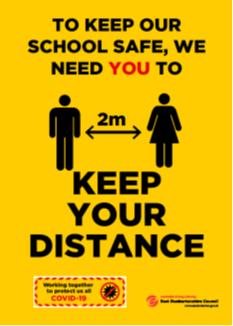
Hand Washing/Sanitising
Regular handwashing or sanitising for more than 20 seconds is essential. Soap and sanitiser is available in the welcome area, all class bases, staffrooms, offices and the school hall. Children can use their own hand sanitiser. If a child has any difficulties with handwashing a support plan will be put in place. Posters are displayed across the school to reinforce the consistent message “To keep our school safe, we need you to wash your hands”.
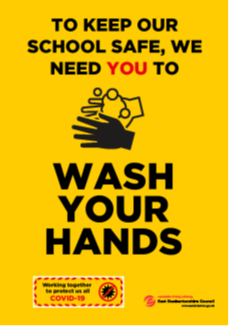
Cleaning and Disinfection
Enhanced leaning/disinfection of work areas and equipment is essential in preventing the spread of Covid-19 within the workplace.
Each school has day cleaners on site from 9am to 3pm. They clean throughout the day. Each base will have a cleaning kit, which contains Unisafe high-level disinfectant and multi surface cleaning pray, blue roll and sanitising wipes for staff to “clean as you go”.
These items are stored safely in bases and offices. Cleaning materials are audited on a weekly basis. The Quality Assurance – FM team continue to visit schools regularly to monitor all aspects of the cleaning provision. Children and young people should be encouraged to keep their work spaces clear and tidy.
Respiratory Hygiene
Everyone is advised to do the following:
- Cover your mouth and nose with a tissue or your sleeve (not your hands) when you cough or sneeze.
- Put tissues in the bin immediately and wash your hands afterwards.
- Do not touch your eyes, nose or mouth. If you do, wash your hands afterwards.
Posters are displayed across the school to reinforce the consistent message “To keep our school safe, we need you to catch and bin your sneezes.”
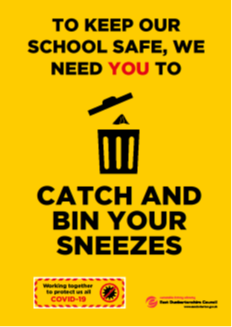
Personal Protective Equipment (PPE) and other protective barrier measures
Processes are in place for the re-ordering of face masks; transparent face coverings; vinyl gloves (day to day duties, including cleaning); nitrile gloves (first aid and personal care); face visors; and transparent face coverings (to support communication with identified pupils).
No PPE is required when undertaking routine educational activities in class bases or the wider school.
The provision and use of PPE is managed through the risk assessment process.
As COVID-19 is a different type of risk to the risks normally faced within a workplace, it requires to be managed through social distancing, good hygiene practices and cleaning/disinfection procedures, rather than through the use of PPE where not required.
PPE must be worn by members of staff who are responding to a suspected case of COVID-19 and by staff who administer first aid and intimate care.
Physical barriers such as glass windows or sneeze guards may be used in office environments.
Face Coverings
Anyone wishing to wear a face covering in any part of the school is permitted to do so.
Face coverings should be worn by adults wherever they cannot keep physical distance from other adults and/or children and young people, unless they are exempt. Face coverings should also be worn at all times when moving around the school and in communal areas.
Parents/carers and other visitors should wear face coverings, including at drop-off and pick-up.
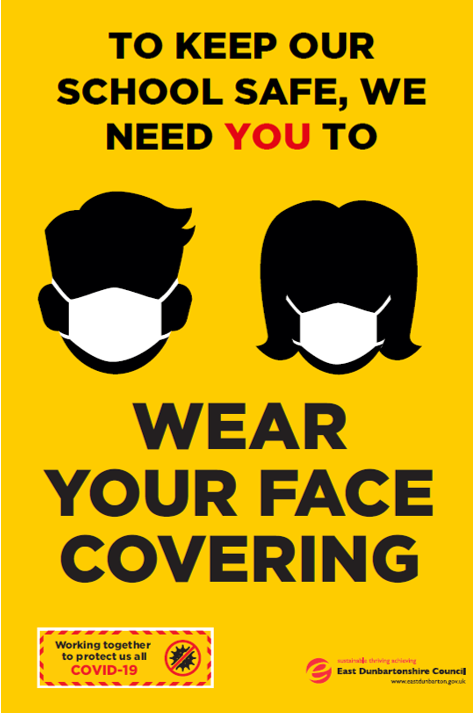
Classroom assistants and those supporting children with additional support needs, who may have to routinely work closely with children, should wear face coverings as a general rule. However, this should be balanced with the wellbeing needs of the child.
Face coverings should be worn by Secondary pupils:
Face coverings should always be worn by secondary pupils in classrooms and communal areas, unless they are exempt.
Secondary pupils are not required to wear face coverings when they are seated for the purpose of eating and/or drinking
Outbreak Management
Public health will offer support and advice to the local authority if consideration is being given to alternative self-isolation policies in the event of significant outbreaks in schools or communities, if they feel this is strictly necessary to manage the situation effectively and mitigate wider impacts.
Where required, Environmental Health, Education and Health & Safety officers will visit the school to investigate outbreaks and recommend added control measures or change practices where this will support other COVID-19 measures.
Remote and Blended Learning
The school will have plans in place to be prepared for sudden or partial school closure and to provide continuity in the provision of learning and teaching. There must also be continuity of provision for individuals when small groups of learners are unable to attend school.
The Digital leader in school will work with staff to ensure that Microsoft Teams is set up for the new school session.
Assemblies
Schools should continue to avoid assemblies and other types of large gatherings, in keeping with the retention of existing mitigations for the first 6 weeks.
School Visitors
Visiting Council officers and specialists can move between schools, where necessary. Consideration should be given to the provision of virtual support.
Parents/Carers Visiting the School
Parents/carers may accompany children onto school premises where this is agreed with the school and is necessary to support children. Any such visits should be risk assessed and agreed in advance. Otherwise, where virtual arrangements for parental engagement are already in place and working well, these should continue to be used.
Dedicated School Transport
Guidance has been updated so that only young people aged 12 and over are required to wear face coverings. Physical distancing between passengers who travel on dedicated school transport is not required and it is considered an extension to the school estate.
Drama, Music, PE and Dance
In line with the move to Level 0 and beyond, children can now engage in these curricular areas, indoors and outdoors, with safety mitigations in place. There are risk assessment in place for these subject areas.
School Procedures
Arriving and Leaving (Staff)
Staff are asked to be mindful of physical distancing when parking and making way to and from the school entrance. All staff must enter and leave via the school’s main entrance. Hand sanitiser is available and must be used when staff enter and leave the building.
Symptom Vigilance
The screening sign below is displayed on the external door of the main entrance for staff and visitors. Staff must self-screen and not enter the building if:
- You have a fever or high temperature
- You have a new persistent cough
- You experience a loss of taste or smell
- You have had contact with any possible source of the virus
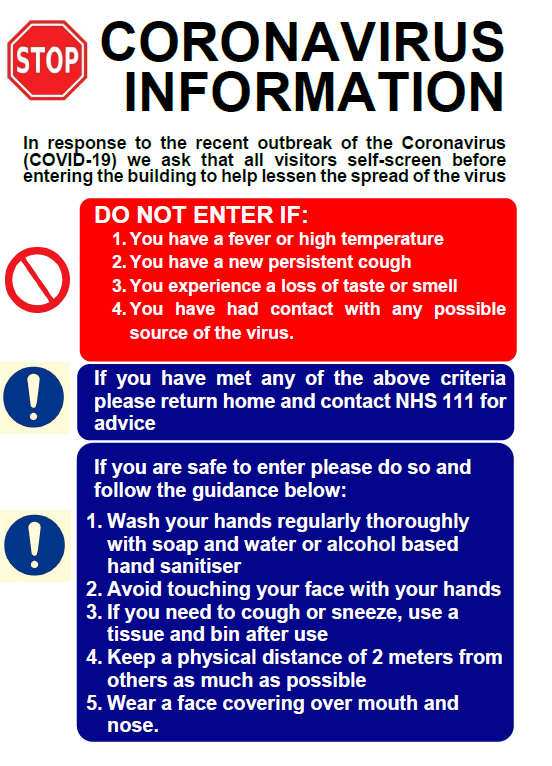
Signing In and Out: COVID-19 Fire Register
All staff must sign in and out every day on the sheet labelled “Fire Register”. This is located at the office reception desk.
Other school mitigations/arrangements
Each school will also have specific processes, protocols and guidance relating to the following matters, and will be tailored to each school, their context and the particular school building:
- School Gates and Grounds (measures to avoid large gatherings)
- Arrangements for Staggered Entry and Exit of Pupils
- Arrangements for Staggered Intervals and Lunches
- Accessing School Areas (one way systems)
- Arrangements for Staff Social Spaces
The table below summarises the approach for key mitigations (August 2021):
|
Mitigation |
Approach (retain/ retain with modifications/ remove/ new) |
Timings |
|---|---|---|
|
Risk assessment |
Retain |
Ongoing |
|
Encouragement of vaccination |
New |
Ongoing |
|
Environmental cleaning |
Retain |
Up to 6 weeks (then contingent on further advice) |
|
Hand and respiratory hygiene |
Retain |
|
|
PPE in specific circumstances |
Retain |
|
|
Face coverings in communal areas |
Retain |
|
|
Face coverings in secondary classrooms |
Retain |
|
|
Physical distancing for adults |
Retain (note change to “at least 1m”, but 2m distancing expected to remain for logistical purposes) |
|
|
One way systems |
Retain |
|
|
Drop-off and pick-up |
Retain |
|
|
Staggered start and stop times/ break and lunch times |
Retain |
|
|
Restrictions on assemblies |
Retain |
|
|
Support for people in the highest risk groups/pregnant staff |
Retain (updated guidance) |
|
|
2x weekly at-home asymptomatic testing |
Retain (updated guidance/materials to support uptake and recording) |
|
|
Outbreak management |
Retain (updated guidance re: public health approach) |
|
|
Self-isolation, contact tracing and testing for adults 18+ |
Retain with modifications (updated guidance – removal of some restrictions for double-vaccinated adult close contacts) |
Align relevant school arrangements with updated approach in wider society ASAP |
|
Self-isolation, contact tracing and testing for U18s |
Retain with modifications (updated guidance – removal of some restrictions for U18 close contacts) |
|
|
Groupings |
Remove |
Reinstated where there are high incidences in schools/classes or year groups- Follow protocol |
|
Ventilation |
Retain (strengthened guidance for LAs on CO2 monitoring) |
Ongoing |
|
Restrictions on Drama, Music, PE and Dance |
Remove (in line with previous guidance) |
Up to 6 weeks (then contingent on further advice) |
|
Restrictions on school visitors |
Retain with modifications (P1 parents/carers permitted to support transition where strictly necessary) |
|
|
School transport |
Retain with modifications (alignment with public transport). |
|
|
School trips |
Retain (updated guidance) |
|
|
Readiness and assurance |
Retain (updated guidance) |
Ongoing |
Mitigations will be kept under constant review, and if data and evidence suggest that any specific mitigations can be removed at an earlier stage advice will be provided to that effect.